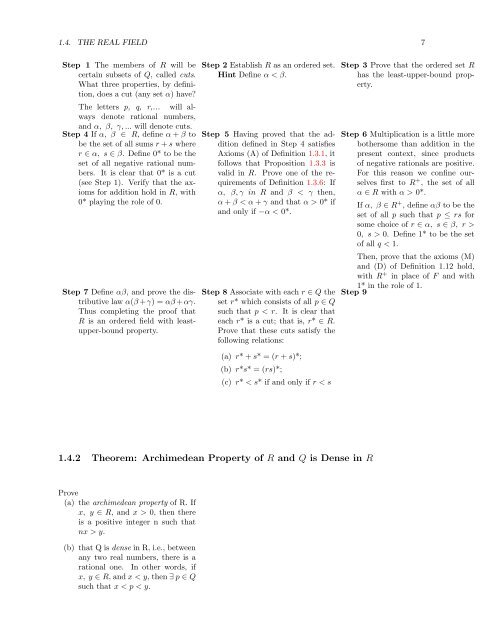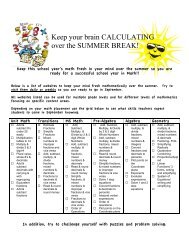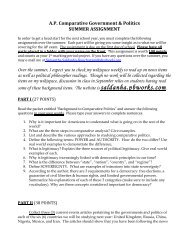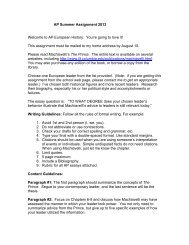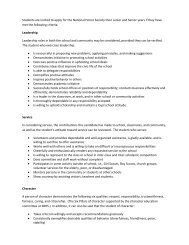Studying Rudin's Principles of Mathematical Analysis Through ...
Studying Rudin's Principles of Mathematical Analysis Through ...
Studying Rudin's Principles of Mathematical Analysis Through ...
You also want an ePaper? Increase the reach of your titles
YUMPU automatically turns print PDFs into web optimized ePapers that Google loves.
1.4. THE REAL FIELD 7<br />
Step 1 The members <strong>of</strong> R will be<br />
certain subsets <strong>of</strong> Q, called cuts.<br />
What three properties, by definition,<br />
does a cut (any set α) have?<br />
The letters p, q, r,... will always<br />
denote rational numbers,<br />
and α, β, γ, ... will denote cuts.<br />
Step 4 If α, β ∈ R, define α + β to<br />
be the set <strong>of</strong> all sums r + s where<br />
r ∈ α, s ∈ β. Define 0* to be the<br />
set <strong>of</strong> all negative rational numbers.<br />
It is clear that 0* is a cut<br />
(see Step 1). Verify that the axioms<br />
for addition hold in R, with<br />
0* playing the role <strong>of</strong> 0.<br />
Step 7 Define αβ, and prove the distributive<br />
law α(β +γ) = αβ +αγ.<br />
Thus completing the pro<strong>of</strong> that<br />
R is an ordered field with leastupper-bound<br />
property.<br />
Step 2 Establish R as an ordered set.<br />
Hint Define α < β.<br />
Step 5 Having proved that the addition<br />
defined in Step 4 satisfies<br />
Axioms (A) <strong>of</strong> Definition 1.3.1, it<br />
follows that Proposition 1.3.3 is<br />
valid in R. Prove one <strong>of</strong> the requirements<br />
<strong>of</strong> Definition 1.3.6: If<br />
α, β, γ in R and β < γ then,<br />
α + β < α + γ and that α > 0* if<br />
and only if −α < 0*.<br />
Step 8 Associate with each r ∈ Q the<br />
set r* which consists <strong>of</strong> all p ∈ Q<br />
such that p < r. It is clear that<br />
each r* is a cut; that is, r* ∈ R.<br />
Prove that these cuts satisfy the<br />
following relations:<br />
(a) r* + s* = (r + s)*;<br />
(b) r*s* = (rs)*;<br />
(c) r* < s* if and only if r < s<br />
Step 3 Prove that the ordered set R<br />
has the least-upper-bound property.<br />
Step 6 Multiplication is a little more<br />
bothersome than addition in the<br />
present context, since products<br />
<strong>of</strong> negative rationals are positive.<br />
For this reason we confine ourselves<br />
first to R + , the set <strong>of</strong> all<br />
α ∈ R with α > 0*.<br />
If α, β ∈ R + , define αβ to be the<br />
set <strong>of</strong> all p such that p ≤ rs for<br />
some choice <strong>of</strong> r ∈ α, s ∈ β, r ><br />
0, s > 0. Define 1* to be the set<br />
<strong>of</strong> all q < 1.<br />
Then, prove that the axioms (M)<br />
and (D) <strong>of</strong> Definition 1.12 hold,<br />
with R + in place <strong>of</strong> F and with<br />
1* in the role <strong>of</strong> 1.<br />
Step 9<br />
1.4.2 Theorem: Archimedean Property <strong>of</strong> R and Q is Dense in R<br />
Prove<br />
(a) the archimedean property <strong>of</strong> R. If<br />
x, y ∈ R, and x > 0, then there<br />
is a positive integer n such that<br />
nx > y.<br />
(b) that Q is dense in R, i.e., between<br />
any two real numbers, there is a<br />
rational one. In other words, if<br />
x, y ∈ R, and x < y, then ∃ p ∈ Q<br />
such that x < p < y.


